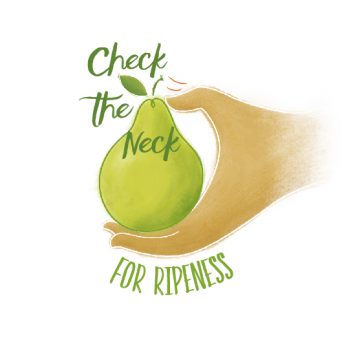Pears – an Amazingly Versatile Fruit!
Pears on pizza? Of course!
Pears are delicious cooked, and they pair really well with cheese. See for yourself with this pancetta pear pizza with honeycomb and thyme recipe.
Bartlett Pear Quesadilla
Pears are just as tasty inside a melty quesadilla. This simple Bartlett pear quesadilla recipe can be prepped and cooked in less than 30 minutes. It’s perfect for a weeknight dinner after a busy day.
Pear Salad with Walnuts, Avocado and Grilled Chicken
On the lighter side, nothing could be simpler than pears in salads. They’re perfect as a meal or as a side to share with friends and family. This salad with pears, walnuts, avocado and grilled chicken will satisfy just about any appetite.
Individual Pear Crisps
Leave room for dessert! Individual pear crisps are simple to make and fun to serve. If you have just a few pears on hand, you can delight a crowd with this cottagecore inspired dessert with no muss or fuss.
Whatever you’re craving, you’ll surely find a new favorite in our online collection of more than 400 recipes, with the convenience of adding the ingredients you need to your online cart with a local retailer.
If you’re looking for a fun snack, check out how you can pummel some spicy chips to create a surprising dip for pear slices.
A Ripe Pear is a Sweet Pear

A little known fact about the pear is that it is one of the few fruits that does not ripen on the tree. The pear is harvested when it is mature, but not yet ripe, and, if left at room temperature, it slowly reaches a sweet and succulent maturity as it ripens from the inside out.
As tempting as the pear might be right from the grocer’s stand, a little bit of patience and know-how will ensure the pear reaches its peak flavor.
So, how do you know when the pear has ripened to sweet and juicy perfection?
While a Bartlett’s skin color brightens as it ripens, most varieties of pears show little change in color.
The best way to judge ripeness for non-Bartlett varieties is to Check the Neck™. Apply gentle pressure to the neck of the pear with your thumb. If it yields to pressure, it’s ripe. Easy, isn’t it?
Here’s what you need to do to ripen your pears:
- Leave firm, unripe pears at room temperature so that they can ripen.
- Check the Neck for Ripeness daily, by applying gentle pressure to the neck, or stem end, of the pear with your thumb. If it yields to pressure, then it’s ripe and ready to eat!
- Once the pear is ripe, it can be refrigerated to slow the ripening process and saved for use up to five days later.
To Prevent Browning:
Keep a fresh fruit fresh
Like many fruits, the flesh of cut or peeled pears will eventually brown. This natural oxidation process won’t affect the taste or quality. However, to keep your pears looking appetizing and to prevent browning, dip them in a mild solution of 50% water and 50% lemon juice!
Refrigerating Pears:
Remember, don’t refrigerate an unripe pear!
Ripened pears can be used at once or put under refrigeration (35º to 45º F) until you want to use them. Refrigeration will delay further ripening but will not stop it altogether, giving you adequate time to include fresh pears in your menu planning. Remember, pears need to ripen at room temperature, so don’t refrigerate an unripe pear!
Speedy Ripening:
Flavor well worth the wait
Place underripe pears in a fruit bowl at room temperature near other ripening fruit like bananas, which naturally give off ethylene and will help speed up the ripening process. And if you find yourself with a few too many overripe pears, blend them into smoothies, soups, sauces and purees!